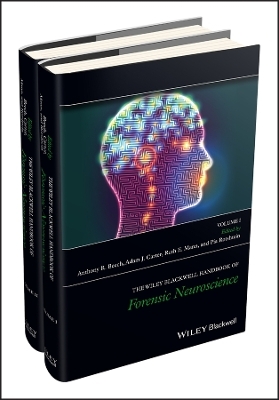
The Wiley Blackwell Handbook of Forensic Neuroscience
John Wiley & Sons Inc (Hersteller)
978-1-118-65086-8 (ISBN)
- Keine Verlagsinformationen verfügbar
- Artikel merken
This book communicates knowledge and research findings in the neurobiological field to those who work with offenders and those who design policy for offender rehabilitation and criminal justice systems, so that practice and policy can be neurobiologically informed, and research can be enhanced.
Starting with an introduction to the subject of neuroscience and forensic settings, The Wiley Blackwell Handbook of Forensic Neuroscience then offers in-depth and enlightening coverage of the neurobiology of sex and sexual attraction, aggressive behavior, and emotion regulation; the neurobiological bases to risk factors for offending such as genetics, developmental, alcohol and drugs, and mental disorders; and the neurobiology of offending, including psychopathy, antisocial personality disorders, and violent and sexual offending. The book also covers rehabilitation techniques such as brain scanning, brain-based therapy for adolescents, and compassion-focused therapy.
The book itself:
Covers a wide array of neuroscience research
Chapters by renowned neuroscientists and criminal justice experts
Topics covered include the neurobiology of aggressive behavior, the neuroscience of deception, genetic contributions to psychopathy, and neuroimaging-guided treatment
Offers conclusions for practitioners and future directions for the field.
The Handbook of Forensic Neuroscience is a welcome book for all researchers, practitioners, and postgraduate students involved with forensic psychology, neuroscience, law, and criminology.
Anthony R. Beech, DPhil, FBPsS, is Professor Emeritus at the University of Birmingham, UK. Adam J. Carter, PhD, is a psychologist working for Her Majesty's Prison and Probation Service, England and Wales. Ruth E. Mann, PhD, is a psychologist working for Her Majesty's Prison and Probation Service, England and Wales. Pia Rotshtein, PhD, is a neuroscientist in the Department of Psychology at the University of Birmingham, UK.
About the editors
List of contributors
VOLUME 1
Section I: Introduction
Chapter 1: Neuroscience in forensic settings: Origins and recent developments
Anthony R. Beech and Dawn Fisher
Chapter 2: A brief introduction to neuroscience
Pia Rotshtein and Ian J. Mitchell
Section II: General neuroscience research
Chapter 3: The neurobiology of aggressive behavior
Jens Foell and Christopher J. Patrick
Chapter 4: The neurobiology of sexual behavior and sexual attraction
Anders Agmo
Chapter 5: Renate
L.E.P. Reniers, Ulrik R. Beierholm & Stephen J Wood
Chapter 6: The neurobiology of emotion regulation
Catherine L. Sebastian & Saz P. Ahmed
Chapter 7: The social neuroscience of empathy and its relationship to moral behavior
Jean Decety and Jason M. Cowell
Chapter 8: The neuroscience of deception
Jennifer M.C. Vendemia & Jimmy M. Nye
Section III: Neurobiology of offending
Chapter 9: The neurobiological underpinnings of psychopathy
Stephane A. De Brito & Ian Mitchell:
Chapter 10: Antisocial Personality Disorder
Sheilagh Hodgins, Dave Checknita, Philip Lindner, Boris Schiffer, and Stephane A. De Brito
Chapter 11: Offenders with Autism Spectrum Disorder
Bjoern Hofvander
Chapter 12:The neuroscience of violent offending
Robert Shug, Jeremy A. Feiger, Gianni G. Geraci, and Heather L. McLernon
Chapter 13: The neuroscience of sexual offending
Andreas Mokros
Chapter 14: The neuroscience of acquisitive/impulsive offending
Claire Nee and Stephanos Ioannou
Chapter 15:
Clare S. Allely
Chapter 16 The neurobiology of offending behavior in adolescence
Graham Fairchild and Areti Smaragdi
Chapter 17: Alcohol-related aggression and violence
Stefan Gutwinski, Adrienne J. Heinz, and Andreas Heinz
VOLUME 2
Section IV: Neurobiological bases to Risk factors for offending
Chapter 18: Genetic contributions to the development of psychopathic traits and antisocial behavior in youths
Nathalie M. G. Fontaine, Eamon J. McCrory, & Essi Viding
Chapter 19: Developmental risk factors
Anthony Beech, Ben Nordstrom, & Adrian Raine
Chapter 20 Mental illness as a putative risk factor for violence and aggression
Ahmad Abu-Akel & Sunne Bo
Chapter 21: Modifying risk factors building strengths
Corine de Ruite
Section V:Rehabilitation
Chapter 22: Engaging with forensic populations: A biologically informed approach
Fiona Williams and Adam J. Carter
Chapter 23: Brain scanning and therapeutics: How do you know unless you look? Neuroimaging guided treatment in forensic settings.
Daniel G. Amen and Kristen Willeumier
Chapter 24:Therapy for acquired brain injury
Nick Alderman, Caroline Knight and Jenny Brooks
Chapter 25:The impact of physical exercise on antisocial behavior: A neurocognitive perspective
Dylan B. Jackson and Kevin M. Beaver
Chapter 26:Treating emotion dysregulation in antisocial behavior: A neuroscientific perspective
Steven M. Gillespie and Anthony R. Beech
Chapter 27:The pharmacological treatment of sex offenders
Don Grubin
Chapter 28:Understanding and using Compassion-Focused Therapy in forensic settings
Russell Kolts and Paul Gilbert
Chapter 29:The neurobiology of eye movement desensitization reprocessing therapy
Derek Farrell
Chapter 30:
Kevin Creeden
Section VI Ethical, Legal and political implications
Chapter 31:The impact of neglect, trauma and maltreatment on neurodevelopment: Implications for juvenile justice practice, programs and policy
Bruce D. Perry, Gene Griffin, George Davis, Jay A. Perry, and Robert D. Perry
Chapter 32: Forensic neuropsychology and violence: Neuroscientific and legal implications
John Matthew Fabian
Chapter 33: Forensic neuropsychology in the criminal court: A socio-legal perspective
Leon McCrae
Chapter 34 Forensic neuropsychology: Social, cultural and political implications
Jessica Pykett
Section VII: Conclusions
Chapter 35 Explanation in forensic neuroscience
Tony Ward and Carolyn E. Wilshire
Chapter 36 Considerations for the forensic practitioner
Adam J. Carter and Ruth E. Mann
| Erscheint lt. Verlag | 16.2.2018 |
|---|---|
| Verlagsort | New York |
| Sprache | englisch |
| Maße | 150 x 250 mm |
| Gewicht | 666 g |
| Themenwelt | Geisteswissenschaften ► Psychologie |
| Naturwissenschaften ► Biologie ► Humanbiologie | |
| Naturwissenschaften ► Biologie ► Zoologie | |
| Recht / Steuern ► Strafrecht ► Kriminologie | |
| ISBN-10 | 1-118-65086-7 / 1118650867 |
| ISBN-13 | 978-1-118-65086-8 / 9781118650868 |
| Zustand | Neuware |
| Informationen gemäß Produktsicherheitsverordnung (GPSR) | |
| Haben Sie eine Frage zum Produkt? |